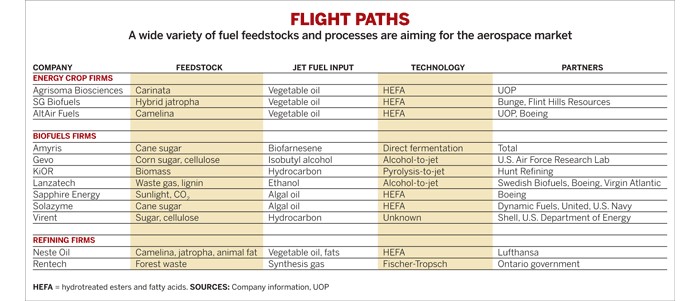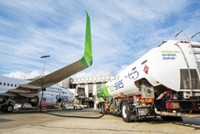Advertisement
Grab your lab coat. Let's get started
Welcome!
Welcome!
Create an account below to get 6 C&EN articles per month, receive newsletters and more - all free.
It seems this is your first time logging in online. Please enter the following information to continue.
As an ACS member you automatically get access to this site. All we need is few more details to create your reading experience.
Not you? Sign in with a different account.
Not you? Sign in with a different account.
ERROR 1
ERROR 1
ERROR 2
ERROR 2
ERROR 2
ERROR 2
ERROR 2
Password and Confirm password must match.
If you have an ACS member number, please enter it here so we can link this account to your membership. (optional)
ERROR 2
ACS values your privacy. By submitting your information, you are gaining access to C&EN and subscribing to our weekly newsletter. We use the information you provide to make your reading experience better, and we will never sell your data to third party members.
Business
Flying The Green Skies With Biofuels
With test flights behind them, airlines push for more production of biobased jet fuel
by Melody M. Bomgardner
June 11, 2012
| A version of this story appeared in
Volume 90, Issue 24

Conferences about biobased fuels and chemicals have been traditionally attended by people who work for firms that make those products and want to show off technology and commercial progress. But in the past two years, a group of motivated and vocal customers has appeared at every major event.
The party crashers don’t want to talk about cellulosic ethanol, biobased specialty chemicals, or renewable gasoline. They come from the airline industry and they want to talk about biobased jet fuel. They know industrial biotech companies have many choices when it comes to what markets to enter, and they are loudly thanking those who choose to supply jet fuel.
At the BIO World Congress on Industrial Biotechnology & Bioprocessing, sponsored this spring by the Biotechnology Industry Organization, Nancy N. Young, vice president of environmental affairs at Airlines for America (A4A), a trade group for U.S. airlines, addressed the root of demand for biobased jet fuel. “Our industry is under the tyranny of petroleum-based crude,” she opened. Young listed three problems faced by the airlines that argue in favor of biofuels: the rising cost of traditional fuel, price volatility, and environmental concerns, particularly greenhouse gas emissions.
“We need another commodity to compete with fossil fuels,” Young stated. And only a drop-in replacement will do, as passenger planes powered by solar energy, electricity, or compressed gas are not going to be part of the solution.
But in the already challenging world of biofuels, the route to jet fuel is plagued by turbulence. Making biobased jet fuel requires an extra refining step and adds costs, which biotech firms fear may not be made up in the price. Only two refining processes are currently certified by the standards organization ASTM International to be used for biobased jet fuel. And abundant feedstocks are not yet available.
Although the bumpy air will slow the arrival of biobased jet fuel, even skeptics agree that eventually there will be meaningful production of the much-wanted fuel. “There is real and genuine demand out there, not just a passing interest,” says Mark Bünger, research director at the advisory firm Lux Research. “As the cost of biobased fuel comes down and the cost of conventional fuel goes up, those lines will cross.”
Several industrial biotech firms have told investors that jet fuel is one possible output from their commercial-scale plants, although it is not clear that the fuel is a priority. In addition, refiners such as Neste Oil have developed technology dedicated to making biobased jet fuel. And a small group of energy crop firms, looking to develop oilseed crops to turn into jet fuel, has emerged.
Between 2009 and 2011, research-scale production of biobased jet fuel was used primarily in test flights. Data from the early flights were used to pursue ASTM certification of biofuels made from waste fats and vegetable oils.
In July 2011, ASTM certified fuels made from hydrotreated esters and fatty acids, or HEFA, as drop-in replacements for conventional jet fuel. Passenger planes can now run on a blend of up to 50% biofuel. The only other way to get biomass into certified jet fuel is to convert it into synthesis gas and use the Fischer-Tropsch reaction to create the fuel. The same process was used by Germany to convert coal to liquid fuels during World War II, and it is still used in South Africa.
The test flights are now over, and scant biofuel is available to buy. Yet the aerospace industry is ready to take on a huge amount of the new fuels: The global market for jet fuels represents a 10% slice of all transportation fuels, or approximately 64 billion gal per year, according to the International Air Transport Association (IATA).
And costs for conventional fuel have been soaring. In 2010, airlines spent $139 billion on jet fuel, an 11% increase over the prior year, according to IATA. The fuel itself was 30% more expensive, but fuel hedging and efficiency gains helped make up some of the difference. Despite those efforts, fuel costs absorbed about 30% of operating expenses for the airlines on average, up from 14% in 2003.
At United Airlines, Robert M. Sturtz, managing director of strategic sourcing for fuel, keeps a close eye on the costs of conventional fuel. “We consume 11 million gal a day at a cost of $35 million, or $25,000 a minute.” He stresses that every dollar increase in a barrel of crude oil costs United another $100 million a year.
Airlines are looking at several ways to manage their fuel costs, Sturtz says, including buying more efficient airplanes and even using jet fuel made from natural gas. In April, Delta Air Lines agreed to purchase an oil refinery near Philadelphia and said it plans to spend $100 million to retool the facility to maximize jet fuel output.
Yet those efforts barely make a dent in the fuel bill. Compounding the problem, efforts to reduce greenhouse gas emissions also will require biofuels. U.S. airlines have set a goal of reducing CO2 emissions 1.5% per year through 2020. And beginning in 2012, European Union regulations require airlines to fly on reduced-carbon-emission fuels or pay a penalty. Those rules also affect U.S. carriers that service EU airports.
United executives had such problems in mind last November when they flew a passenger plane from Houston to Chicago on a blend of 40% algae-based fuel, supplied by Solazyme and its partner, UOP, and 60% conventional jet fuel. Sturtz shrugs off critics who point out that airlines paid six times the cost of regular fuel for the biofuel used in the demonstration.

When the industry moves to project-level quantities, Sturtz says he expects to pay $5.50 to $7.00 per gal. Airlines, however, can recoup some of this cost through biofuels credit trading permitted under the federal renewable fuels standard. Because airlines are not federally required to use biofuel, they can sell their biofuel credits for about $2.00 per gal to firms that are regulated.
Jet fuel is made from a blend of midlength hydrocarbons. “It is very clean and very special kerosene,” says Ron Cascone, a principal at the consulting firm Nexant. “The demands on jet fuel are very high. It has to be the right fuel all the time, no mistakes.”
At process technology firm UOP, a division of Honeywell, Jim Rekoske has had the opportunity to make jet fuel from at least 40 different biobased feedstocks. In his role as general manager of UOP’s renewable energy and chemicals business, he has put the feedstocks through the HEFA process and Fischer-Tropsch chemistry to make ASTM-certified fuels. The company licenses its technology to oil refiners as well as to stand-alone biofuel facilities.
Unlike other fuels, Rekoske says, biobased jet fuel must go through an extra refining step, at a cost of $4.00 to $5.00 per bbl, to add hydrogen and remove oxygen. In addition to the HEFA and Fischer-Tropsch processes, Rekoske says, UOP is developing technologies to make jet fuel from biobased alcohol or pyrolysis oil. UOP plans to send samples of alcohol-derived jet fuel to the Federal Aviation Administration (FAA) in June as part of a program to achieve ASTM certification.
UOP has worked closely with Solazyme to make jet fuel from algae using the HEFA process. The algae are custom designed to maximize production of vegetable-like oil tailored to jet fuel requirements, says Robert M. Ames, Solazyme’s vice president of fuels commercialization. They are grown in fermentation vessels and can be fed a range of sugars including cane, corn, and cellulosic sugars.
“We can change the profile of the algal oil anywhere from the C10–C12 to the C18–C20 range,” Ames says. “In addition, we can play with saturation levels, double bonds, and oxygen atoms and tailor the amount of saturation for downstream processing. The more highly saturated the molecule, the less hydrogen will be required to convert that algal oil molecule into jet fuel.”
But as Rekoske points out, the main reason biobased jet fuel costs more than conventional jet fuel is the cost of the feedstocks, which are a limited commodity. He puts them at the equivalent of $150 to $160 per bbl, whereas conventional jet fuel sells for $120 to $130 per bbl. The only way for all the players in the supply chain to make fuel and turn a profit is through a project-level agreement or long-term joint venture where everyone shares the profit and the risk, he says.
It will require multiple feedstocks and a number of years, analysts say, before enough material will be grown to supply the aerospace industry with notable amounts of biofuels. “The feedstock issue is amazingly daunting,” says Michael J. Ritzenthaler, an analyst at investment bank Piper Jaffray & Co. “We may be several years from widespread adoption of fuel crops in the U.S.”
On the other hand, as new routes to jet fuel are certified by ASTM, it will be easier to optimize feedstock production regionally. Regional production is favored by A4A and its research partners, which include FAA and aircraft and engine manufacturers. For example, forest wastes might be the feedstock of choice in the Pacific Northwest and Southeast, whereas cold-weather crops such as camelina could be grown in the upper Midwest and Canada.
Commercial airlines are also hoping that military support for biofuels will help scale up feedstock production and lower costs. In December, the Navy contracted with Dynamic Fuels, a biorefining joint venture between Tyson Foods and Syntroleum, to buy 450,000 gal of renewable fuels, including 100,000 gal of jet fuel. Solazyme helped Dynamic fulfill the contract. This July, the fuel will be used to power the Navy’s Great Green Fleet on exercises off the coast of Hawaii.
The military’s support is now in question, though, because members of the House of Representatives and Senate Armed Services Committees have inserted language into defense spending bills to prohibit the military from spending more on alternative fuels than on traditional fossil fuels.
But additional government help is on the way. In July 2010, the Department of Agriculture announced the Farm to Fly program, in which it will work with FAA to evaluate ways to promote sustainable feedstocks and develop aviation biofuel production and distribution.
To download a PDF of this article with a table showing flight paths, visit http://cenm.ag/flight.
And the airline industry, in addition to throwing its weight behind public policies that promote biobased jet fuel, is offering purchase agreements to firms making certified biobased jet fuel, A4A’s Young says. When asked if companies would help finance commercial facilities, she replied, “Capital investment into the biofuel industry has not been a favored approach for the airlines, which have been cash-strapped due to economic conditions. But we do not rule anything out.”
For the time being, there are “lots of buyers, not many sellers,” Nexant’s Cascone says. “The need is great. Since everyone has the same planes, all an airline can do is get its fuel cheaper or more securely. It’s why they are willing to invest and to show up at these meetings. They have to be players—they are playing now to be in a position to be supplied later.”







Join the conversation
Contact the reporter
Submit a Letter to the Editor for publication
Engage with us on Twitter